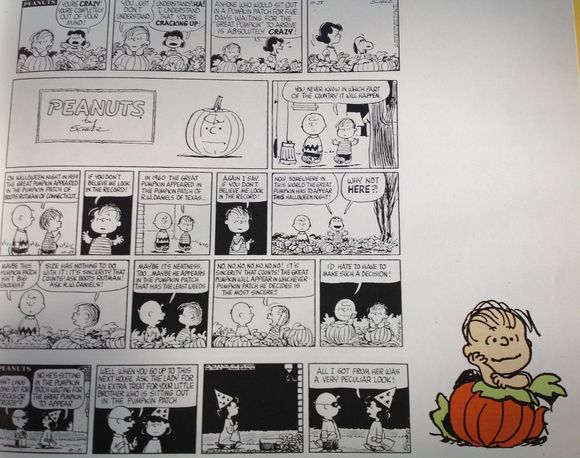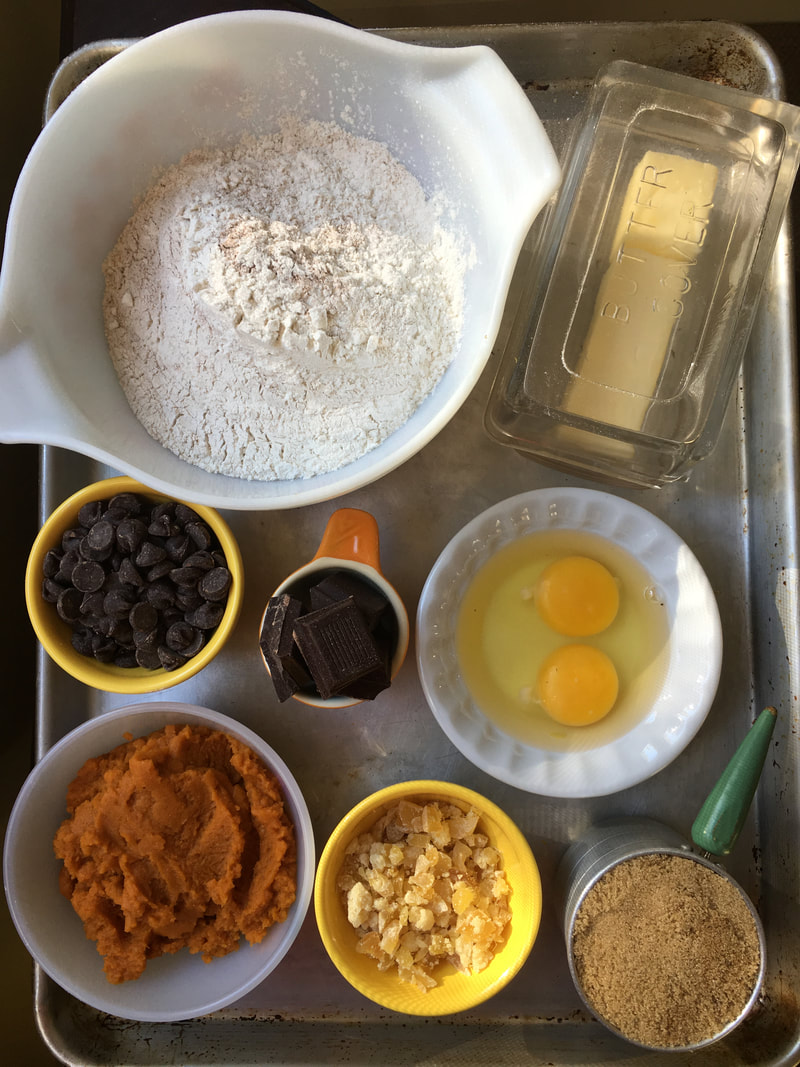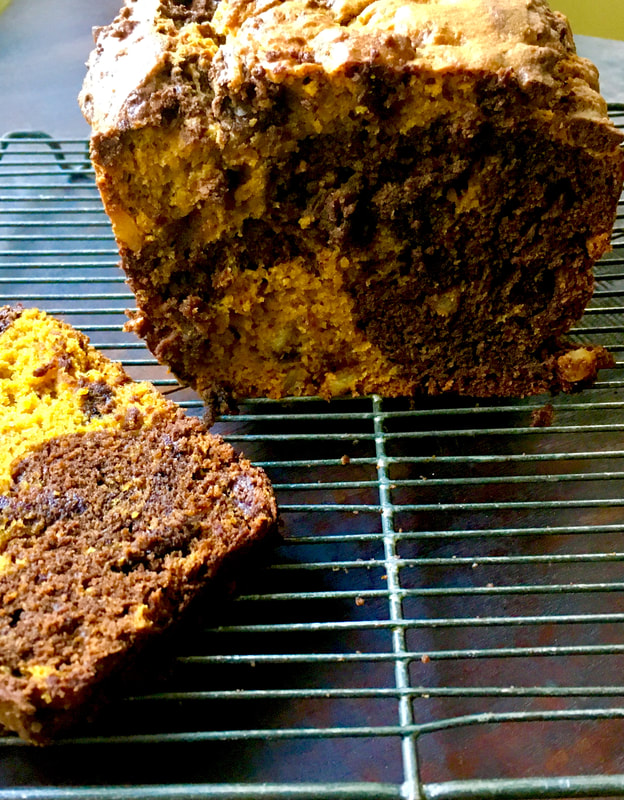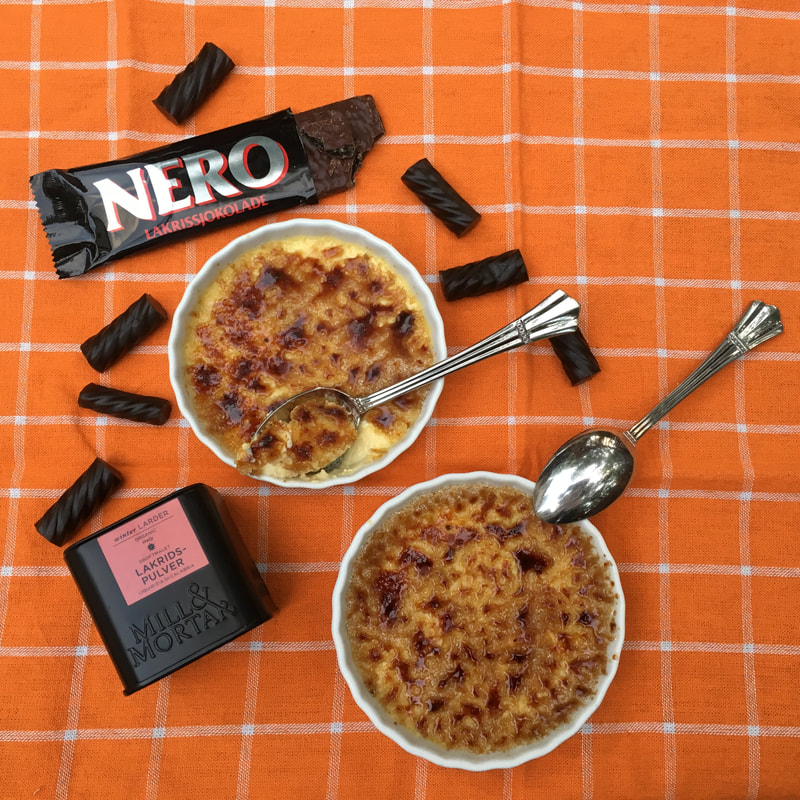|
from Jennifer Bartoli (with a few adjustments)
makes one loaf, baked in a pan measuring 8½” x 4½” x 2¾” (Note: the loaf bakes best in a loaf pan with a capacity of 1.5 L which is a little bit more than 6 cups of batter. Opt for a glass Pyrex loaf pan rather than a metallic pan, which tends to over darken the cake. My pan measures 8½” x 4½” x 2¾”) 2 cups all-purpose flour 1 1/4 teaspoon baking powder 1/2 teaspoon baking soda 1/4 teaspoon salt 1 teaspoon cinnamon 1/2 teaspoon ground ginger 1/4 teaspoon nutmeg 1/8 teaspoon ground cloves 1/8 teaspoon finely ground fresh black pepper 1 teaspoon orange zest 3/4 cups semi-sweet chocolate chips 1/3 cup crystallized ginger, diced 2/3 cup unsalted butter, softened 1 cup packed brown sugar 2 eggs 1 cup canned pumpkin (if using fresh pumpkin puree, strain well in cheesecloth) 2 tablespoons sour cream or yogurt 1 teaspoon vanilla 4 oz. dark chocolate, melted/slightly cooled (I use Trader Joe’s 60%) Grease the bottom and sides of a glass loaf pan measuring 8½” x 4½” x 2¾” (1.5 L capacity) then line the bottom with parchment paper; lightly grease the parchment paper. In a large bowl, whisk together flour, baking powder, baking soda, salt, cinnamon, ginger, nutmeg, cloves, black pepper, and orange zest. Stir in the chocolate chips and crystallized ginger. Set aside. Preheat your oven to 350 degrees F. In the bowl of a standing mixer fitted with the paddle attachment, beat butter with brown sugar until fluffy. Beat in eggs, 1 at a time; then add the pumpkin puree, sour cream (or yogurt) and vanilla (mixture may appear separated). With mixer on low, gradually add flour mixture in three additions. Scrape down sides and bottom of the bowl. Remove half of the batter to separate bowl; fold cooled/melted chocolate into 1 bowl of the batter until combined. Alternately drop spoonfuls of light and dark batters into parchment paper–lined loaf pan. Using a small paring knife, gently swirl batters to marbleize. Smooth the top of the loaf using a small offset spatula. Bake on the middle rack of a preheated 350° F oven until loaf tests clean with a knife, about 70 minutes. If the loaf needs more time, reduce the oven temperature to 325 degrees F, cover the top of the loaf with a sheet of parchment paper, and bake for an additional 5-7 min. Let cool in pan for 15 minutes. Lift out onto rack; peel off parchment paper. Let cool completely before slicing. (The batter fills the pan almost to the top- keep an eye on baking time and adjust the temperature from 350 degrees F down to 325 degrees F if the top is getting too dark but the center needs more time.) Best served Halloween morning with a cup of strong coffee.
0 Comments
Adapted from BBC Good Food and Paul Hollywood
makes four servings (Note: Seek out good quality, soft black licorice. Trader Joe’s carries several varieties. Twizzlers brand relies heavily on corn syrup and artificial flavoring; save those for movie-going.) For the Custard- 1½ cups heavy cream 1 cup whole milk 4.5 oz. soft black licorice, cut into small pieces ½ vanilla bean, split, seeds scraped using tip of a small paring knife 5 large egg yolks pinch salt 3 tablespoons sugar optional: 1 teaspoon of licorice flavored liqueur (Pernod, Jagermeister, Meesterbitter, or Anisette) or if you are lucky enough to own a black tin of Mill & Mortar Lakrids-Pulver, ⅛ teaspoon of licorice powder. For the Brulée Topping- In a small bowl, stir together until combined: 2 tablespoons granulated sugar 2 tablespoons brown sugar To prepare the custard, place the cream, milk, vanilla bean, (and its seeds) and the licorice pieces in a small saucepan. Heat gently until the cream and milk just comes to a boil, stirring occasionally with a rubber scraper. Remove from the heat and let the mixture sit for one hour to infuse. Line a large baking pan with a cotton dishtowel. Place four ramekins, each measuring 4½” across x 1” deep, on top of the towel, inside the baking pan. (If you don’t have ramekins that size, you can use 7 or 8 oz. ovenproof dishes. The baking time may vary a little.) When the licorice cream has steeped for one hour, pre-heat the oven to 325 degrees F. Place the egg yolks in a medium bowl. Whisk the salt and sugar into the egg yolks. Return the licorice cream mixture to the stovetop and reheat briefly over medium heat just to warm it, DO NOT LET IT COME TO A BOIL. Place a fine mesh strainer over a heatproof bowl and strain the licorice cream, pressing on the solids. Temper the egg mixture with the cream by gradually adding the strained licorice cream to the egg yolks, whisking the mixture without letting it get frothy. If you wish to add liqueur to the custard, (or licorice powder) do so now. It’s a good idea to strain the mixture once more through a fine mesh strainer into a container with a spout, (such as a Pyrex measuring cup) before dividing it between your oven-proof dishes. Carefully set the baking dish with the custards on the middle rack of the oven. Pour hot water carefully into the pan, being careful not to splash any water into the ramekins. The water should come up a little more than halfway up the side of the ramekins. This will serve as the water bath for the custards. Bake for 25-30 minutes, or until the custards are just set, but still have a slight jiggle in the middle. Remove the baking dish with the custards from the oven, then carefully remove the custards from the water bath (a wide spatula works well) and set them on a rack to cool completely. Cover each custard with plastic wrap and chill completely in the refrigerator until serving. To brulée the custards, remove the plastic wrap, dab the surface of the custards with a paper towel to remove any excess moisture, then sprinkle each custard with 1 tablespoon of the sugar mix. Using a small kitchen torch, caramelize the sugar until it melts and turns deeply golden. (To be honest, I have always had access to a kitchen torch. If you don’t have one, you can turn your oven to “broil” and caramelize the sugar by placing the cooled custards on a baking sheet and placing them on the top shelf of the oven, close to the heat source. This will only take a few minutes, depending on the oven, so stay close.) Remove from the oven and let the caramel set for a few minutes before serving. (Don’t forget to turn off your oven.) fills one 9” springform pan
inspired by Café Bozz and Winkel Café, Amsterdam adapted from Marie Asselinand and the barkeep from Café Bozz For the pie pastry- 12 ounces (3 sticks) unsalted butter, room temperature 1⅓ cups packed dark brown sugar 1/2 teaspoon salt 2 eggs, room temperature 4¾ cups King Arthur self-rising flour (or you can substitute 4¾ cups all-purpose flour + 1 teaspoon baking powder) egg wash made from one egg beaten with 1 tablespoon of heavy cream or milk sanding sugar In the bowl of a standing mixer fitted with the paddle attachment, beat the butter, brown sugar, and salt until creamy, scraping down the sides and the bottom of the bowl to make sure the mixture is well combined. With the mixer on low, add the eggs one at a time until incorporated. Add the flour in thirds (about 1¼ cups at a time) scraping down the bowl well after each addition. (The pastry is quite soft and feels a little bit like cookie dough.) Scrape the dough out of the bowl onto a sheet of lightly floured parchment paper. Take about one third of the dough, pat it into a disc and wrap it in plastic wrap. This will be the top crust. Take the remainder of the dough, pat it into a disc and wrap it in plastic wrap. This will be the bottom crust. Let the pastry rest while you prepare the filling. It’s fine sitting on the counter (unless your kitchen is excessively hot.) For the Speculaaskruiden (Dutch Spice Blend) (You will only need to use 3 teaspoons of this spice blend in the pie) 2 tsp. ground cinnamon ½ tsp. ground cloves ½ tsp.ground mace ¼ tsp. ground ginger ⅛ tsp. ground cardamom ⅛ tsp. ground coriander seeds ⅛ tsp. white pepper or ground pink peppercorns ⅛ tsp. ground nutmeg ⅛ tsp. ground anise seeds Measure all of the spices into a small bowl and whisk together to combine. Measure out 3 teaspoons of the spice mix for your pie. Save the remainder in a small glass jar or airtight container. (Combined with sugar it’s great sprinkled over gingersnaps, gingerbread, sugar cookies, or French toast.) For the filling- 4 pounds apples (use a combination of sweet and tart; preferably apples that will hold their shape – Northern Spy, Braeburn, Pink Lady, Macoun) zest from 1 lemon zest from 1 small orange 2 teaspoons lemon juice ⅓ cup dark brown sugar 3 teaspoons Speculaaskruiden 2 tablespoons cornstarch 2 tablespoons rum or applejack or calvados generous ½ cup golden raisins generous ½ cup walnut halves, coarsely chopped Rinse, peel, halve, and core the apples. Depending upon your preference, you can thinly slice the apples (about ⅛” thick) or cut them into sizable chunks, about ½” thick. (At Café Bozz in Amsterdam, the apples are thinly sliced, at Winkel they are cut into chunks.) Place the apple slices/chunks into a large mixing bowl. Toss with the lemon juice and zests. In a medium bowl, whisk together the brown sugar, 3 teaspoons of the spice blend, and the cornstarch. In a small bowl, combine the rum or applejack or calvados with the raisins. (The barkeep at Café Bozz insisted that rum was key to the recipe, but any of the spirits will be a fine addition, or even a good quality apple cider.) Leave everything for a few minutes while you preheat your oven to 375 degrees F and roll out the pie pastry. Cut a circle of parchment paper to fit the bottom of the springform pan. Butter the sides and bottom of the pan, place the parchment circle in the bottom of the pan, then butter the parchment and dust the pan with flour. Tap out the excess. Roll out the larger portion of pie pastry on a lightly floured sheet of parchment paper, into a circle approximately 12” in diameter. Carefully dust the circle of dough with a little flour, fold the dough in half and half again, gently transfer the dough to the springform pan and unfold it, gently pressing the dough along the bottom and smoothing it up the sides of the pan. Create a sturdy rim around the top edge of the pan by tucking about 1” of the overhanging dough under itself then crimp it decoratively. Refrigerate the springform pan with the bottom crust. Roll out the remaining dough on the sheet of parchment paper into a circle about 11” in diameter; this will be your top crust. Slide the parchment with the top crust onto a baking sheet and refrigerate while you complete the filling. Add the brown sugar/spice/cornstarch mixture to the apples, then the tipsy raisins and the walnuts. Use a rubber spatula to thoroughly combine the mixture. Retrieve the bottom and top crusts from the refrigerator. Place the springform pan on a parchment lined baking sheet. Turn the filling into the springform pan and place the top crust over the fruit. Seal the top crust to the bottom, trimming away any excess dough. (You want a fluted edge but you don’t want to have too much excess dough making it tricky to remove the outer ring of the pan.) Brush the top crust with some of the egg wash and sprinkle with the sanding sugar. Cover the edges of the pie with strips of aluminum foil. Place the baking sheet on the bottom rack of the preheated oven. Bake for 50 minutes then reduce the oven temperature to 350 degrees F, and carefully remove the aluminum foil strips from the edge of the pie. Move the pie from the bottom rack to the middle rack and bake for an additional 10-15 minutes, or until the apples feel tender when tested with a small paring knife. (This is a weighty pie and it’s important for the bottom crust to bake thoroughly and the apples to be tender, not crunchy.) Remove the pie from the oven and set on a rack to cool. The pie must cool completely, and then some, in order to turn it out from the springform. It is best to bake this early in the day or the evening before you plan to serve it. The slices will be much neater if the pie has a chance to totally set. Use a serrated knife to slice and serve with whipped cream or vanilla ice cream and plenty of dark, strong coffee. Wrap any leftovers in plastic wrap and store at room temperature for up to two days; after that you should refrigerate any lingering slices. |
Archives
July 2024
|




 RSS Feed
RSS Feed